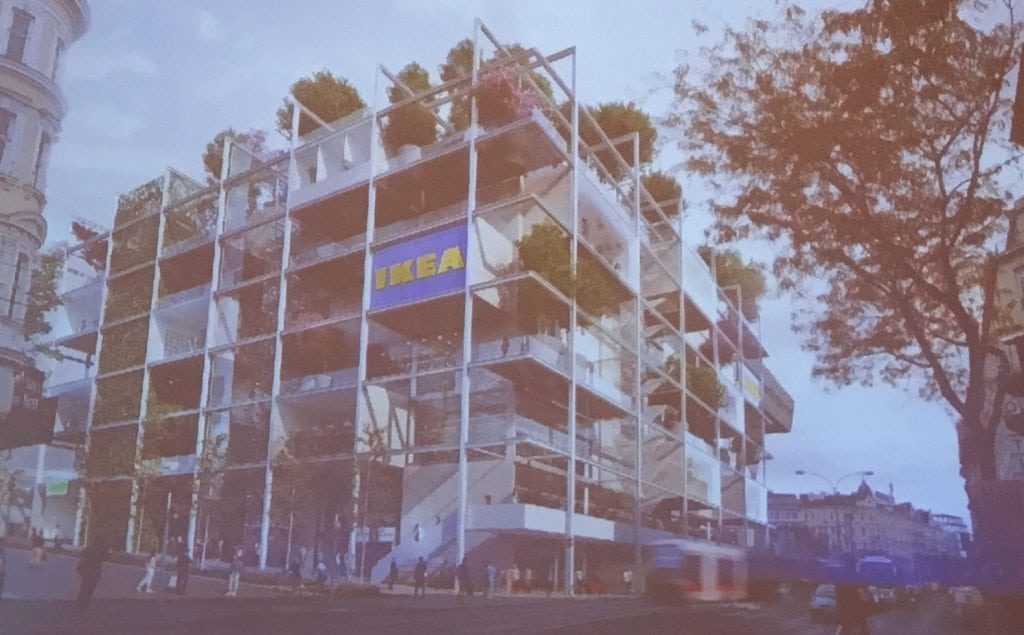With augmented reality and inner-city stores, IKEA aims to disrupt itself
"Disrupt" is an unpopular marketing buzzword, but that's exactly what IKEA is doing with technological enhancements and more stores in cities.
"Disrupt" is an unpopular marketing buzzword, but that's exactly what IKEA is doing with technological enhancements and more stores in cities.
“Disruptive” may be the marketing buzzword people hate the most, but it’s fitting here. IKEA isn’t disrupting a product or even an industry; the Swedish furniture giant is aiming to disrupt itself.
IKEA’s massive blue warehouses have long been staples of the suburbs. Four years ago, the brand tried thinking outside the big blue box and opened a store on a busy street in Hamburg, Germany. Initially an experiment, inner-city stores have become a key part of IKEA’s strategy. One is slated to open in New York City this spring with 30 more planned over the next two years.
“We’re pivoting from the big blue box 30 minutes out in the countryside,” Nicholas Cooper, IKEA’s VP of Property and Retail Establishment, said at Worldwide Business Research’s Future Stores conference over the summer. “We were looking for potato fields all these years. We need to meet the customer wherever they want to meet us. In the U.S., we know we have a huge increase in ecommerce sales. We also know we have millions of people who come to the store every week. How do we match the two?”
A digital rendering of the smaller, taller urban IKEA of the future
IKEA’s “Planning Studio” will focus on “smart solutions for urban living and small spaces.” The first Manhattan location will be 17,500 square feet; the average warehouse is 320,000. There won’t be a warehouse and many products will be available for delivery only.
In other words, the Planning Studio will be unlike everything IKEA is known for.
“Given the space constraints, urban locations require retailers to think about their product and fulfillment strategies differently,” says JoAnn Martin, VP of Retail Industry Strategy at JDA Software, an Arizona company that provides supply chain planning and execution strategies for retailers. “As a result, retailers are leveraging artificial intelligence and machine learning to automate the curation of their assortments to be customer-focused and support supply chain orchestration to fulfill demands.”
IKEA’s North America headquarters is located in Conshohocken, Pennsylvania, a Philadelphia suburb. Manhattan doesn’t have the smallest apartments in the U.S., but it’s close. Naturally, those smaller living spaces—and fewer cars to bring purchases there—yield different demands. If there is, in fact, a Hell, it involves trying to transport a BILLY bookcase on the 6 train.
Americans keep moving to cities, even if they’re not quite as dense as New York or Seattle. As of the 2015 census, U.S. cities made up 3.5% of the country’s land area but 62.7% of the population.
“The more localized, personalized assortment you can offer in a smaller, less expensive space—especially in an urban area with 20 times the population in a half-mile radius—the better,” says Martin. “Even if you needed intra-day delivery, the store can be incrementally more profitable. It’s about ‘right sizing’ and figuring out who retailers can have a mix of location and store sizes to provide great service to the biggest number of customers.”
IKEA isn’t just moving toward city centers in a physical sense. The brand’s technological investments also demonstrate a commitment to the urban consumer, who may otherwise flock to Amazon or Wayfair.
For one, there’s augmented reality. The IKEA Place app, which boasts millions of downloads, allows consumers to virtually place furniture. They can see what the products look like in their homes, potentially increasing excitement around the purchase. Urban shoppers can also ensuring the items actually fit. If Hell is attempting to bring an IKEA bookcase on the subway, how about having to bring it back because it didn’t fit?
Last year, IKEA also acquired TaskRabbit, an app that pairs consumers with freelance labor. “Assemble IKEA furniture” is now a specific task on TaskRabbit’s website, solving another traditional pain point for the furniture giant.
Founded in 1943, IKEA is recognizable all over the world. Remember when luxury fashion house Balenciaga released a bright blue purse and everyone immediately said it looked like IKEA’s iconic tote bag? But customers are fickle and don’t care about heritage. Sears was the largest retailer in the U.S., until it wasn’t.
IKEA’s dedication to digital transformation and evolving shows that the brand likely won’t appear on CB Insights’ retailer bankruptcy timeline any soon. Speaking alongside his colleague Cooper at Future Stores, IKEA Project Manager Phil Szuch said, “Playing it safe and not doing anything is the riskiest thing we can do.”